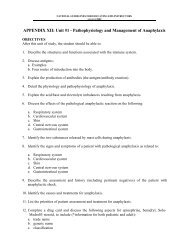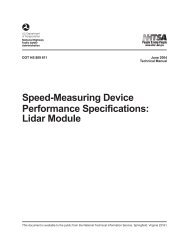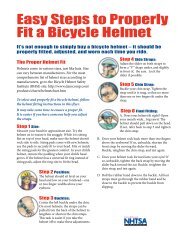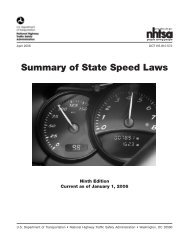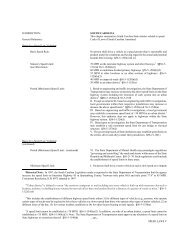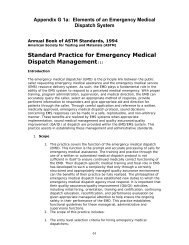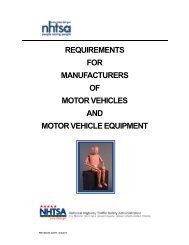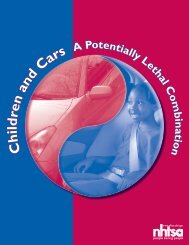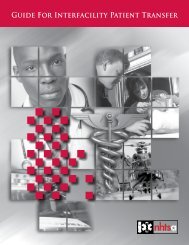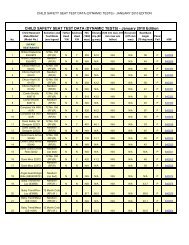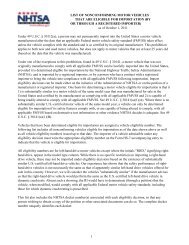The Criminal Justice System: A Guide for Law Enforcement ... - NHTSA
The Criminal Justice System: A Guide for Law Enforcement ... - NHTSA
The Criminal Justice System: A Guide for Law Enforcement ... - NHTSA
You also want an ePaper? Increase the reach of your titles
YUMPU automatically turns print PDFs into web optimized ePapers that Google loves.
Were traffic lights working properly? What was the weather like? What were the lighting<br />
conditions? What evidence has been secured to document the details (photos of the<br />
scene, the vehicles, and the victims; scale drawings; photographing in place and then<br />
securing crash debris)?<br />
<strong>The</strong> variables are many and all need to be discussed between the police,<br />
prosecutor, and crash reconstructionist to determine appropriate criminal charges, if any,<br />
and how to proceed at trial.<br />
If the case warrants criminal charges, what can the crash reconstructionist expect<br />
at trial? He or she will have to discuss the pre-impact, impact/engagement, and postimpact—the<br />
moments just be<strong>for</strong>e the crash, the dynamics of the crash, and the immediate<br />
results after the crash. 6<br />
At trial, after having gone through the general areas of inquiry <strong>for</strong> all expert<br />
witnesses (see above) and possibly having been questioned by the defense attorney, the<br />
prosecutor will ask you to explain what you did in this case:<br />
• You were contacted by the prosecutor?<br />
• Did you review the police report, including photographs, scale drawings, and<br />
statements?<br />
• Did you visit the scene (evidence still present or no longer present)?<br />
• Did you do scale drawings/calculations using accepted math <strong>for</strong>mulas?<br />
• What were the results of those calculations?<br />
Notice what’s missing from that list? <strong>The</strong>re is no need to go into great detail<br />
about specific calculations you did or the math and science of crash reconstruction, at<br />
least not when answering the prosecutor’s questions. However, be prepared to explain on<br />
cross examination—the questions asked by the defense attorney after you’ve answered<br />
the prosecutor’s questions—the calculations you used and the laws of physics you relied<br />
on to reach your conclusions.<br />
OPTOMETRISTS<br />
Horizontal Gaze Nystagmus (HGN) and its application to impaired driving has<br />
been known <strong>for</strong> years. However, it is likely brand new to the juror hearing this testimony in<br />
an impaired-driving case. While we’ve all heard “the eyes are the windows to the soul,”<br />
how many of us knew our eyes can provide strong evidence of impairment due to alcohol<br />
and some other drugs? That is the challenge faced by prosecutors and optometrists who<br />
need to convey this “novel” phenomenon to a jury—and sometimes a judge.<br />
6 For further details, see APRI’s Crash Reconstruction Basics <strong>for</strong> Prosecutors authored by John Kwasnoski<br />
and available <strong>for</strong> downloading at http://www.ndaa-apri.org/publications/apri/traffic_law.html.<br />
23



